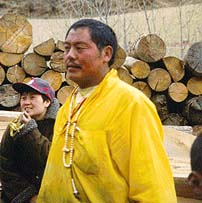Tenzeng Nyima, manager and chief
accountant, Baiya Monastery.Xiong Xiong at 50-odd years old is an old-fashioned Tibetan, the chief engineer for the KAF/CERS monastery conservation project. A dusty, fur-hatted, chuba-clad character, he hails from Dege, way out there in the middle of eastern Tibet. I have called him down to Kangding, at the edge of the plateau, to save me half of the seven-day round trip journey.
He has brought Baiya Monastery’s manager, Tenzeng Nyima, a monk dressed in maroon robes, likewise dusty with a lingering aroma of yak butter about him. The two have come to report on expenditures for the preceding seventeen months of construction at Baiya. This is something we do periodically, and it’s one of my responsibilities as Project Manager.
Neither Tenzeng Nyima nor Xiong Xiong has ever been to accounting school; nor, for that matter, have I. But we all understand the importance of receipts, and Tenzeng has some 200 to show me. Here is a sampling of some items (all amounts are given in rmb, which are currently running about eight to the US dollar):
96.7.12 Gauze to protect murals during construction, 420. 96.7.10 Cigarettes for officials, 204. 96.9.2 Food for carpenters, 1,671. 96.10.2 Transportation of injured workers, 2,325. 96.10.20 Rope, 70. 96.11.7 Coal for heating, 144. 96.11.25 Wages, Stone-cutters, 300. 96.12.3 Medical care for injured workers, 1,352.91. 96.12.25 Wages, Unskilled laborers, 522. 97.3.10 Nails, 350. 97.3.25 Beer for driver who worked overtime, 60. 97.4.1 Yak-hide coracle ferry for transportation of workers across the upper Yangtze, 106. 97.5.11 Medical care for driver injured in fistfight, 123. 97.5.15 Wages, Clay workers, 1,290. 97.6.16 Paint, 46. 97.7.20 Wages, new driver, 1,300. 97.8.19 Wages, carpenters, 18,260. 97.9.16 Telegram to Chengdu, 26.64 97.10.26 Travel expenses, roundtrip, for two to Kangding, 1,450.There are stories behind many of these entries. For example, in May the driver for the monastery’s tractor got into a fistfight with another man. Xiong Xiong fired him, but decided to pay his doctor bills. (I informed Xiong Xiong that we will no longer cover injuries resulting from brawls).
In China, it’s a standard practice to give cigarettes to officials, or indeed anyone whom one is friendly with, and however much I dislike this custom it’s necessary to get things done. It’s also customary to feed the senior carpenters. They earn the lion’s share of wages, not because they are expensive (20-45 yuan per day per man), but because we need so many of them. It’s gratifying to know that so much of the money we spend is going directly into the pockets of these backcountry workers.
One big expense item that I didn’t include in the sample is our tractor. The receipts tell the story of a long-suffering, cantankerous machine, kept barely alive by its loving but parsimonious owners. Tractor parts account for no fewer than sixteen receipts, for a total of rmb1,483.54, not counting the new engine (rmb2,980). The driver, who is also the mechanic, earns 16 yuan a day and has the most regular employment of anyone except Xiong Xiong himself. CERS bought this machine for Baiya three years ago, for 14,800 yuan. It is, I am proud to say, a deluxe tractor, with a handsome engine cover, enough power to haul some 10 adults, and an exhaust pipe that does not spew fumes directly into the face of the driver as the standard tractor does.
The entry for Dec 12 arose from an accident during transportation of some villagers who had volunteered to help with the construction. Because of bad brakes, the tractor overturned on a steep slope. Three people were injured, including the driver, and one elderly woman was killed on the spot. Xiong Xiong immediately contacted Baiya Rinpoche, the incarnate lama who is the religious leader of Baiya Monastery. He came at once, making the long trip from Chengdu to Baiya in March, one of the worst seasons for travel. He visited the bereaved family several times, offered prayers for the dead woman and gave her family a cow among other gifts. They pronounced themselves satisfied, and willingly applied their thumbprints to a letter stating so. Xiong Xiong explained the whole thing to me very straightforwardly, saying “I’ve got to tell you the bad news as well as the good” as he showed me the letter.
The first time I reviewed project receipts, in 1995, Tenzeng Nyima had grouped them according to no discernible system, and folded each stack into square origami. The origami squares were then tied into a cloth of yellow silk. As Tenzeng untied the accounting bundle and dumped all the receipt-squares onto the table, I sensed that here was an accounting system unlike any I’d ever seen before.
We went through all the stacks, tallying each receipt one by one. Some were offical receipts, written in Chinese, dated and stamped on a special form of a pattern used throughout China. Most, however, were handwritten on scraps of tissue-thin paper. They were written in Chinese, Tibetan, or a mixture; most were undated, and some had only thumbprints for signatures. The Tibetan receipts often had only Tibetan numerals on them. Of all the sums that Tenzeng Nyima and Xiong Xiong had calculated, not one was correct.
This year the system has been improved: we have now graduated to envelopes. The receipts are numbered, most are dated, and Xiong Xiong keeps a separate notebook listing each. I still have to carefully check their arithmetic, but the success rate is up to around 70% and errors have decreased in magnitude.
Baiya, too, is doing well, and soon the construction work will be complete, and we will be able to put back the murals we peeled off from damaged walls last year. A few more months, and these receipts that I so carefully tally will add up to a new Baiya Monastery.
